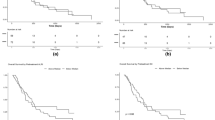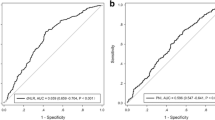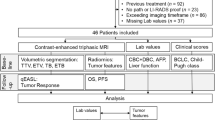Abstract
Background
The serum neutrophil–lymphocyte ratio (NLR) is associated with outcomes in several solid organ cancers, including hepatocellular carcinoma (HCC).
Methods
We reviewed our experience in patients with HCC who underwent transarterial chemoembolization (TACE) as the initial treatment. Serum complete blood counts were used to calculate the NLR before and after TACE. The Kaplan–Meier method was used to determine survival and significant differences between groups by the log-rank test.
Results
There were 103 patients identified who underwent TACE for HCC. The median age was 60.5 years. Median overall survival was 12.6 (95 % confidence interval 8.3–17) months. Median survival in patients with a high preprocedural NLR was 4.2 months compared to 15 months in those with a normal NLR (p = 0.021). In those whose NLR either rose 1 month after treatment or remained elevated, survival was worse compared to those who normalized or remained normal (18.6 vs. 10.6 months, p = 0.026). The same was true at 6 months (21.3 vs. 9.5 months, p = 0.002). An unresponsive NLR was associated with very poor outcome (median survival 3.7 months). Multivariate analysis of clinicopathologic factors showed that presence of extrahepatic disease and high NLR were independent factors associated with worse survival.
Conclusions
Our study demonstrates that periprocedural trends of serum NLR are associated with outcome in unresectable HCC undergoing TACE. Serum NLR is easy to calculate from a routine complete blood count with differential. Along with liver function, serum NLR may be helpful to clinicians in providing prognostic information and monitoring response to therapy.


Similar content being viewed by others
References
Parkin DM, Bray F, Ferlay J, Pisani P. Estimating the world cancer burden: GLOBOCAN, 2000. Int J Cancer. 2001;94:153–6.
Altekruse SF, McGlynn KA, Reichman ME. Hepatocellular carcinoma incidence, mortality, and survival trends in the United States from 1975 to 2005. J Clin Oncol. 2009;27:1485–91.
El-Serag HB, Rudolph KL. Hepatocellular carcinoma: epidemiology and molecular carcinogenesis. Gasroenterology. 2007;132:2557–76.
Llovet JM, Burroughs A, Bruix J. Hepatocellular carcinoma. Lancet. 2003;362:1907–17.
Llovet JM, Bruix J. Systematic review of randomized trials for unresectable hepatocellular carcinoma: chemoembolization improves survival. Hepatology. 2003;37:429–42.
Tan CK, Law NM, Ng HS, Machin D. Simple clinical prognostic model for hepatocellular carcinoma in developing countries and its validation. J Clin Oncol. 2003;21:2294–8.
Schoniger-Hekele M, Muller C, Kutilek M, Oesterreicher C, Ferenci P, Gangl A. Hepatocellular carcinoma in Central Europe: prognostic features and survival. Gut. 2001;48:103–9.
Bruix J, Llovet JM. Prognostic prediction and treatment strategy in hepatocellular carcinoma. Hepatology. 2002;35:519–24.
Roxburgh CS, McMillan DC. Role of systemic inflammatory response in predicting survival in patients with primary operable cancer. Future Oncol. 2010;6:149–63.
Jung MR, Park YK, Jeong O, et al. Elevated preoperative neutrophil to lymphocyte ratio predicts poor survival following resection of late stage gastric cancer. J Surg Oncol. 2011;104:504–10.
Azab B, Bhatt VR, Phookan J, et al. Usefulness of the neutrophil-to-lymphocyte ration in predicting short- and long-term mortality in breast cancer patients. Ann Surg Oncol. 2012;19:217–24.
Kobayashi N, Usui S, Kikuchi S, et al. Preoperative lymphocyte count is an independent prognostic factor in node-negative non-small cell lung cancer. Lung Cancer. 2012;75:223–7.
Hung HY, Chen JS, Yeh CY, et al. Effect of preoperative neutrophil–lymphocyte ratio on the surgical outcomes of stage II colon cancer patients who do not receive adjuvant chemotherapy. Int J Colorectal Dis. 2011;26:1059–65.
Chen TM, Lin CC, Huang PT, Wen CF. Neutrophil-to-lymphocyte ratio associated with mortality in early hepatocellular carcinoma patients after radiofrequency ablation. J Gastroenterol Hepatol. 2012;27:553–61.
Halazun KJ, Hardy MA, Rana AA, et al. Negative impact of neutrophil–lymphocyte ratio on outcome after liver transplantation for hepatocellular carcinoma. Ann Surg. 2009;250:141–51.
Gomez D, Farid S, Malik HZ, et al. Preoperative neutrophil-to-lymphocyte ratio as a prognostic predictor after curative resection for hepatocellular carcinoma. World J Surg. 2008;32:1757–62.
Zahorec R. Ratio of neutrophil to lymphocyte counts—rapid and simple parameter of systemic inflammation and stress in critically ill. Bratisl Lek Listy. 2001;102:5–14.
Bruix J, Sherman M, Llovet JM, et al. Clinical management of hepatocellular carcinoma. Conclusions of the Barcelona-2000 EASL conference. European Association for the Study of the Liver. J Hepatol. 2001;35:421–30.
Mazzaferro V, Regalia E, Doci R. Liver transplantation for the treatment of small hepatocellular carcinomas in patients with cirrhosis. N Engl J Med. 1966;334:693–9.
Balkwill F, Mantovani A. Inflammation and cancer: back to Virchow. Lancet. 2001;357:539–45.
Satomi A, Murakami S, Ishida K, Mastuki M, Hashimoto T, Sonoda M. Significance of increased neutrophils in patients with advanced colorectal cancer. Acta Oncol. 1995;34:69–73.
Schmidt H, Suciu S, Punt CJ, et al. Pretreatment levels of peripheral neutrophils and leukocytes as independent predictors of overall survival in patients with American joint committee on cancer stage IV melanoma: results of the EORTC 18951 Biochemotherapy trial. J Clin Oncol. 2007;25:1562–9.
Donskov F, Bennedsgaard KM, Hokland M, et al. Leukocyte orchestration in blood and tumour tissue following interleukin-2 based immunotherapy in metastatic renal cell carcinoma. Cancer Immunol Immunother. 2004;53:729–39.
Bertuzzo VR, Cescon M, Ravaioli M, et al. Analysis of factors affecting recurrence of hepatocellular carcinoma after liver transplantation with a special focus on inflammation markers. Transplantation. 2011;91:1279–85.
Huang ZL, Luo J, Chen M, Li JQ, Shi M. Blood neutrophil-to-lymphocyte ratio predicts survival in patients with unresectable hepatocellular carcinoma undergoing transarterial chemoembolization. J Vasc Interv Radiol. 2011;22:702–9.
Author information
Authors and Affiliations
Corresponding author
Rights and permissions
About this article
Cite this article
McNally, M.E., Martinez, A., Khabiri, H. et al. Inflammatory Markers are Associated with Outcome in Patients with Unresectable Hepatocellular Carcinoma Undergoing Transarterial Chemoembolization. Ann Surg Oncol 20, 923–928 (2013). https://doi.org/10.1245/s10434-012-2639-1
Received:
Published:
Issue Date:
DOI: https://doi.org/10.1245/s10434-012-2639-1




